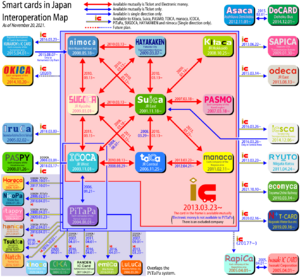Finance:ICOCA
The ICOCA (イコカ Ikoka) card is a rechargeable contactless smart card used on JR West rail network in Japan . The card was launched on November 1, 2003 for usage on the Urban Network, which encompasses the major cities of Osaka , Kyoto and Kobe (Keihanshin). It is now usable on many other networks.
ICOCA stands for IC Operating CArd, but it is also a play on the phrase "Iko ka" (行こか), an informal, Kansai dialect invitation meaning "Shall we go?" in Japanese (the standard, Tokyo dialect equivalent is "Ikō ka" (行こうか)).
The mascots for the ICOCA program consist of a blue platypus (or duckbill) called Ico the Platypus (カモノハシのイコちゃん Kamonohashi no Iko-chan) and Icota and Icomi the Platypuses (カモノハシのイコ太とイコ美 Kamonohashi no Ikota to Ikomi).
Functions/services
Usage of the card involves passing it over a card reader. The technology allows for the card to be read at some distance from the reader, so contact is not required, and many people leave the card in their wallet and just pass the wallet over the reader as they enter the ticket gate.
The balance on the card is displayed when you enter the ticket gate this way. The balance is also displayed whenever the card is inserted into the ticket or fare adjustment machines as well. A travel record is stored on the card, and can be displayed or printed out as well, at the fare adjustment machines.
On occasion, when travelling to a station where ICOCA is not supported, the card must be handed over to the staff at the exiting station, so that they can calculate the remaining fare, and also so that they can return a slip of paper which must be given to the staff at the next station where ICOCA is used.
ICOCA functions as a boarding ticket (乗車券 jōshaken), and also have a commuter pass (定期券 teikiken) added to it. However, for express services, such as Haruka service to Kansai airport, on which an additional fee is required, ICOCA can only be used as fare ticket (乗車券 jōshaken) (for passing the ticket gate) for non-reserved travel, with the express ticket purchased from the conductor on board the train – see train tickets in Japan.
Types of cards
- standard ICOCA rechargeable card
- ICOCA 定期券 (teikiken) – rechargeable card with added commuter pass
- こどもICOCA (kodomo) – children's ICOCA
- こどもICOCA 定期券 – children's ICOCA with added commuter pass
- Smart ICOCA
- Smart ICOCA 定期券
- KIPS ICOCA – this card is sold by Kintetsu
- KIPS ICOCA 定期券 – this card is sold by Kintetsu
Interoperation
Via a number of reciprocal agreements, for ordinary fares, ICOCA can be used interoperably with various other mass transit smart card systems. As of 2014, ICOCA has interoperability with Kitaca, Suica, PASMO, TOICA, manaca, PiTaPa, SUGOCA, nimoca, hayakaken and several other local smart cards.
- Since August 1, 2004, in a reciprocal agreement with JR East, ICOCA is also usable in the Tokyo-Kantō area. Conversely, the Suica card of JR East can also be used on JR West rail services.
- Since January 21, 2006, ICOCA cards can also be used at all locations accepting Osaka PiTaPa smart cards.
- Since September 1, 2007, ICOCA is also usable in the Hiroshima-Okayama area.
- Since March 29, 2008, in a reciprocal agreement with JR Central, ICOCA is also usable in the Nagoya metropolitan area. Similarly, the TOICA card of JR Central can also be used on JR West rail services.
- Since March 5, 2011, in a reciprocal agreement with JR Kyushu, ICOCA is also usable in the Fukuoka-Saga area. Similarly, the SUGOCA card of JR Kyushu can also be used on JR West rail services.
- Since June 1, 2011, Keihan started selling its ICOCA.
- Since March 17, 2012, ICOCA became usable in some stations of JR Shikoku.
- Since December 1, 2012, Kintetsu started selling its ICOCA.
- Since March 23, 2013, nationwide inter-operation among 10 transportation smart cards started.
Where to buy the card
These cards are available at card vending machines at the train stations. The card costs 2000 yen, which includes a 500 yen deposit that will be returned if the card is turned in. The remaining 1500 yen is immediately available for train rides, and more money can be charged on to the card at similar ticket vending machines or fare adjustment machines inside each station.
Technology
The card incorporates contactless RFID technology developed by Sony, called FeliCa. The same technology is also deployed in the Edy electronic cash cards used in Japan, the Octopus card in Hong Kong & the old ezlink Card in Singapore.
See also
- Mass transit systems
- Electronic money
- List of smart cards
External links




